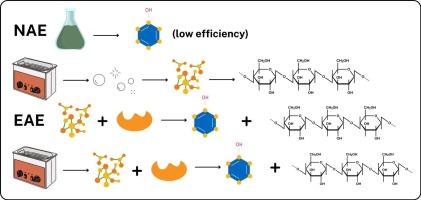Enhancing phenolic and flavonoid recovery from Vietnamese balm using green solvent-based ultrasonic-enzymatic-assisted extraction
IF 9.7
1区 化学
Q1 ACOUSTICS
引用次数: 0
Abstract
The research explored the extraction of phenolic and flavonoids from Elsholtzia ciliata (Vietnamese balm) using a natural deep eutectic solvent (NADES)-based ultrasonic-enzymatic-assisted extraction (UAE-EAE) technique. A range of NADESs was evaluated to investigate the most suitable solvent system. The NADES synthesized from lactic acid and choline chloride provided the highest recovery of phenolics and flavonoids. Single-factor experiments were conducted to assess how individual process variables influence the recovery of phenolics and flavonoids. Key factors affecting extraction performance were assessed using the Plackett-Burman approach. Optimal conditions were established through the Box-Behnken Design model. The optimal extraction parameters for TPhC were determined as a solid-to-liquid ratio (SLR) of 1:59 g/mL, water content (WC) of 12 %, ultrasonic temperature of 43 °C, ultrasonic time of 6.88 min, and incubation time of 6.33 min. For TFlC, the optimal conditions were established at SLR of 1:67 g/mL, WC of 14 %, and enzyme activity of 1.28 U/g. Under these optimized conditions, UAE-EAE achieved the maximum recovery of total phenolic content (36.41 ± 2.50 mg GAE/g) and total flavonoid content (18.74 ± 1.28 mg QE/g). A second-order kinetic model was adopted to analyze the extraction mechanism. Structural and surface changes in the plant matrix before and after extraction were further investigated using scanning electron microscopy (SEM) and X-ray diffraction (XRD). This method demonstrates high efficiency and eco-friendliness in extracting plant-derived bioactive compounds using NADES-based UAE-EAE.

绿色溶剂型超声-酶辅助萃取法提高越南香脂中酚类和类黄酮的回收率
研究了以天然深共熔溶剂(NADES)为基础的超声-酶辅助提取(UAE-EAE)技术对越南香薷中酚类和黄酮类物质的提取工艺。对一系列NADESs进行了评价,以确定最合适的溶剂体系。由乳酸和氯化胆碱合成的NADES对酚类和黄酮类化合物的回收率最高。通过单因素实验考察了各工艺变量对酚类和黄酮类化合物回收率的影响。使用Plackett-Burman方法评估影响提取性能的关键因素。通过Box-Behnken设计模型建立了最优条件。最佳提取条件为:料液比1:59 g/mL,水含量12%,超声温度43℃,超声时间6.88 min,超声培养时间6.33 min。最佳条件为SLR为1:67 g/mL, WC为14%,酶活性为1.28 U/g。在此优化条件下,UAE-EAE的总酚含量(36.41±2.50 mg QE/g)和总黄酮含量(18.74±1.28 mg QE/g)的回收率最高。采用二级动力学模型分析萃取机理。利用扫描电子显微镜(SEM)和x射线衍射仪(XRD)进一步研究了提取前后植物基质的结构和表面变化。该方法利用nades基UAE-EAE提取植物源性生物活性化合物具有较高的效率和环保性。
本文章由计算机程序翻译,如有差异,请以英文原文为准。
求助全文
约1分钟内获得全文
求助全文
来源期刊

Ultrasonics Sonochemistry
化学-化学综合
CiteScore
15.80
自引率
11.90%
发文量
361
审稿时长
59 days
期刊介绍:
Ultrasonics Sonochemistry stands as a premier international journal dedicated to the publication of high-quality research articles primarily focusing on chemical reactions and reactors induced by ultrasonic waves, known as sonochemistry. Beyond chemical reactions, the journal also welcomes contributions related to cavitation-induced events and processing, including sonoluminescence, and the transformation of materials on chemical, physical, and biological levels.
Since its inception in 1994, Ultrasonics Sonochemistry has consistently maintained a top ranking in the "Acoustics" category, reflecting its esteemed reputation in the field. The journal publishes exceptional papers covering various areas of ultrasonics and sonochemistry. Its contributions are highly regarded by both academia and industry stakeholders, demonstrating its relevance and impact in advancing research and innovation.
 求助内容:
求助内容: 应助结果提醒方式:
应助结果提醒方式:


